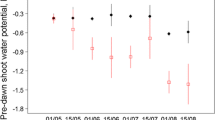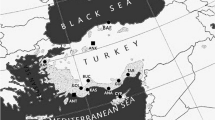Abstract
Six pine taxa were compared for freeze hardiness following 2 whole plant freeze tests carried out in early and late winter 1993–94. Pure species included slash pine (Pinus elliottii var. elliottii Engelman) (PEE), Caribbean pine (Pinus caribaea Morelet) var. bahamensis (PCB), and var. hondurensis (PCH). The same six slash pine parents served as the female parents of the pure slash pine taxon and were control pollinated to create the F1 hybrids of slash pine × Caribbean pine var. bahamensis (F1B), the F1 of slash pine × Caribbean pine var. hondurensis (F1H), and the backcross of slash pine × (slash pine × var. hondurensis (B1H). Four traits related to adaptation (bud set, foliage/stem damage, survival) were compared. Significant differences existing among the three species at all temperatures for both freeze tests. The 3 hybrid taxa were intermediate to parental taxa for all measured traits and only at extreme temperatures was there an indication of hybrid vigor. However, inspection of foliage damage curves to estimate temperatures at which 50 percent damage occurs indicated that the hybrids deviated from the mid parent value toward the more freeze susceptible parent. Discriminant functions which included foliage damage and survival traits provided the best segregation of taxa groupings and the combining of canonical variable 1 for these discriminant functions placed hybrids intermediate to parental taxa. Parent × taxa interaction was significant, suggesting that within these taxa, family to family variation occurred, but different maternal parents were associated with the freeze hardly families in different taxa.
Similar content being viewed by others
References
Afifi, A. A. and Clark, V. 1984. Computer-aided Multivariate Analysis. Lifetime Learning Publications, Belmont, Calif., p. 458.
Asahina, E. 1978. Freezing processes and injury in plant cells, pp. 17–37. In: Li, P. H. and Sakai, A. (Eds) Plant Cold Hardiness and Freezing Stress. Academic Press, Inc., London.
Bonner, F. T., McLemore, B. F. and Barnett, J. P. 1974. Presowing treatment of seed to speed germination, p. 883. In: Seeds of Woody Plants in the United States. USDA/FS Agr. Handbook, Washington, D.C. 450.
Burton, G. W. 1980. Utilization of hybrid vigor, pp. 184–203. In: Wood, D. R. (Ed) Crop Breeding. American Society of Agronomy, Madison, WI.
Duncan, P. D. 1994. First-year growth, morphology, and freeze hardiness of pure species and hybrid taxa of Pinus elliottii and Pinus caribaea. M.S. thesis, University of Florida, Gainesville, p. 55.
Hodge, G. R. and Weir, R. J. 1993. Freezing stress tolerance of hardy and tender families of loblolly pine. Can. J. For. Res. 23: 1892–1899.
Hyun, S. K. 1976. Interspecific hybridization in pines with the special reference to Pinus rigida × taeda. Silvae Genet. 25: 188–191.
Kolb, T. E., Steiner, K. and Barbour, H. F. 1985. Seasonal and genetic variation in loblolly pine cold tolerance. Forest Sci. 31: 926–932.
Kraus, J. F. 1986. Breeding shortleaf × loblolly pine hybrids for the development of fusiform rust-resistant loblolly pine. South. J. Appl. For. 10: 195–197.
La, Farge, T. and Kraus, J. F. 1980. A progeny test of (shortleaf × loblolly) × loblolly hybrids to produce rapid growing hybrids resistant to fusiform rust. Silvae Genet. 29: 197–200.
Liesenfeld, D. R., Auld, D. L., Murray, G. A. and Swensen, J. B. 1986. Transmittance of winter hardiness in segregated populations of peas. Crop Science 26: 49–54.
Limin, A. E. and Fowler, D. B. 1988. Cold hardiness expression in interspecific hybrids and amphiploids of the Triticeae. Genome 30: 361–365.
Mikola, J. 1982. Bud-set phenology as an indicator of climatic adaptation of Scots pine in Finland. Silvae Fenn. 16: 178–184.
Nikles, D. G. 1991. Increasing the Value of Future Plantations in Argentina and Southern Brazil using Slash × Caribbean Pine Hybrids Developed in Queensland. Jornadas sobre Pinus caribaea. Centro de Investigaciones y Experiencias Forestales, Buenos Aires, Argentina, pp. 1–9.
Nikles, D. G. and Robinson, M. J. 1989. The development of Pinus hybrids for operational use in Queensland, pp. 272–282. In: Gibson, G. I., Griffin, A. R. and Matheson, A. C. (Eds) Breeding Tropical Trees: Population Structure and Genetic Improvement Strategies in Clonal and Seedling Forestry. Oxford For. Inst., Oxford, UK.
Norell, L., Eriksson, G., Ekberg, I. and Dormling, I. 1986. Inheritance of autumn frost hardiness in Pinus sylvestris L. seedlings. Theor. Appl. Genet. 72: 440–448.
Rehfeldt, G. E. 1977. Growth and cold hardiness of intervarietal hybrids of Douglas fir. Theor. Appl. Genet. 50: 3–15.
SAS Institute. 1988. SAS/STAT Guide for Personal Computers. SAS Institute, Inc. Cary, N.C., p. 378.
Sluder, E. L. 1970. Shortleaf × Loblolly Pine Hybrids Do Well in Central Georgia. Georgia For. Res. Paper No. 64, Georgia Forest Research Council, Macon, GA, pp. 1–4.
South, D. B., Donald, D. G. M. and Rakestraw, J. L. 1993. Effect of nursery practice and bud status on freeze injury to Pinus taeda and P. elliotti seedlings. S. Afr. For. J. 166: 37–45.
Sutcliffe, J. 1977. Plants and Temperature. Camelot Press Ltd., Southhampton, UK, p. 57.
Sutka, J. 1981. Genetic studies of frost resistance in wheat. Theor. Appl. Genet. 59: 145–152.
Tibbits, W. N., Hodge, G. R. and White, T. L. 1991. Predicting breeding values for freezing resistance in Eucalyptus globulus. In IUFRO Symposium Intensive Forestry: The Role of Eucalypts. Sept. 2–6, Durban, South Africa, pp. 330–333.
Wells, O. O., Barnett, P. E., Derr, H. J., Funk, D. T., La, Farge, T., Lawson, E. R. and Little, S. 1978. Shortleaf × slash pine hybrids outperform parents in parts of the Southeast. South. J. of Appl. For. 1: 28–32.
Author information
Authors and Affiliations
Additional information
This is Florida Agricultural Experiment Station Journal Series No. R-04852 of the Institute of Food and Agricultural Sciences, University of Florida, Gainesville, FL, 32611
Rights and permissions
About this article
Cite this article
Duncan, P.D., White, T.L. & Hodge, G.R. First-year freeze hardiness of pure species and hybrid taxa of Pinus elliottii (Engelman) and Pinus caribaea (Morelet). New Forest 12, 223–241 (1996). https://doi.org/10.1007/BF00027933
Received:
Accepted:
Issue Date:
DOI: https://doi.org/10.1007/BF00027933




